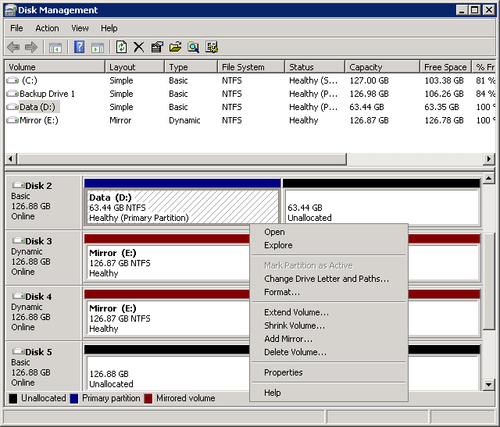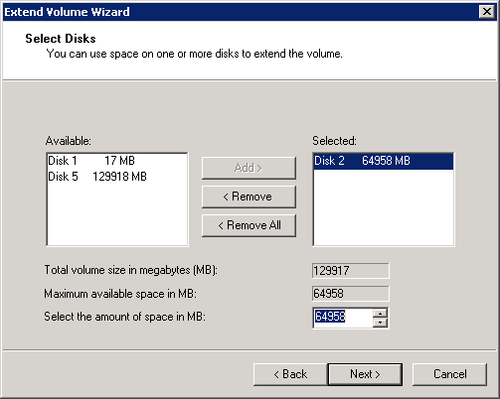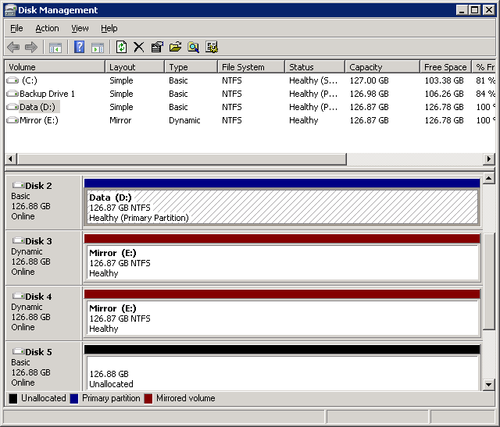2. Extending or Shrinking a Volume
Windows Small Business Server 2011 has the ability to extend
or shrink a volume, on the fly, without shutting down the server or
rebooting. When you shrink a volume, you create unallocated space on
the volume. That unallocated space can then be used to extend
another volume.
2.1. Shrinking a Volume
The ability to shrink a volume is a new feature added to
Windows Server 2008, giving you greater flexibility in managing
your disks. Before Windows Server 2008, you had to use a
third-party application to shrink a volume. And even now
third-party applications such as Acronis Disk Director give you
greater flexibility and control over resizing partitions and
volumes than Disk Management. With Disk Management, you can shrink
down the unused space on a volume, recovering some of that empty
space to use on other volumes, but the most you can expect to
recover is about 50 percent of the free space on the volume. If
the file system on the volume is fragmented, you might not get
even that much.
To shrink a volume, follow these steps:
Open the Disk Management console if it isn’t already
open.
Select the volume you want to shrink and right-click to
open the menu shown in Figure 11.

Select Shrink Volume from the menu to open the Shrink
dialog box shown in Figure 12.

Select the amount to shrink the volume and then click
Shrink to change the size of the volume.
2.2. Extending a Volume
You can add space to a volume without having to back up,
reboot, and restore your files if it is a simple volume or a
spanned volume. You do this by converting the volume to a spanned
or extended volume that incorporates unallocated space
on any disk. Unfortunately, you can’t increase the size of a
mirrored, striped, or RAID-5 volume simply by adding disks to the
array.
Note:
Some hardware RAID controllers support dynamically
expanding RAID volumes. When combined with hot-add disks, this
gives you a far more flexible solution for managing your
internal storage. But even after you’ve extended a hardware RAID
volume, you’ll still need to extend it using Diskmanager or
Diskpart.
To extend a volume, complete the following steps:
In the Disk Management console, right-click the volume
you want to extend. Choose Extend Volume to open the Extend
Volume Wizard.
Click Next to open the Select Disks page, select one or
more disks from the list of disks that are available and have
unallocated space. Click Add to add the selected disk or
disks, and indicate the amount of space you want to add, as
shown in Figure 13.

Click Next and the Extend Volume Wizard displays a final
confirmation page before extending the volume. Click Finish to
extend the volume. The extended volume is shown in Figure 14.

Warning:
IMPORTANT A spanned
(extended) volume is actually less reliable than a simple disk.
Unlike a mirror or RAID-5 volume, which has built-in redundancy,
a spanned or striped volume will be broken and all its data lost
if any disk in the volume fails.
|
Most people responsible for supporting a busy server have
wished at some point that they could simply increase the space
of a particular volume or drive on the fly when it got low on
space—preferably without having to bring the system offline for
several hours while the entire volume is backed up and
reformatted to add the additional hard disks, the backup is
restored, and the share points are re-created. Fun? Hardly.
Risky? Certainly. And definitely a job that means coming in on
the weekend or staying late at night—in other words, something
to be avoided if at all possible.
All this makes SBS’s ability to create additional space on
a volume without the need to back up the volume, reformat the
disks, and re-create the volume a seductive feature. However,
unless you’re running hardware RAID, you should think twice
before jumping in. Only simple or spanned volumes allow you to
add storage on the fly, and because neither is redundant, using
them exposes your users to the risks of a failed drive. Yes, you
have a backup, but even under the best of circumstances, you’ll
lose some data if you need to restore a backup. Further, using
spanned volumes actually increases your risk of a hard disk
failure. If any disk used as part of the spanned volume fails,
the entire volume is toast and will need to be restored from
backup.
Why, then, would anyone use spanning? Because they have
hardware RAID to provide the redundancy. This combination offers
the best of both worlds—redundancy provided by the hardware RAID
controller and flexibility to expand volumes as needed, using
Disk Management. Yet another compelling argument for hardware
RAID, as if you needed any more.
|
Note:
Windows Small Business Server 2011 uses the terms
extended and spanned
nearly interchangeably when describing volumes. Technically,
however, a spanned volume must include more than one physical
disk, whereas an extended volume can also refer to a volume that
has had additional space added to the original simple volume on
the same disk.